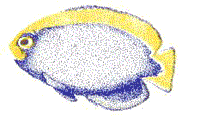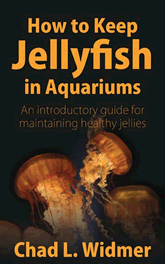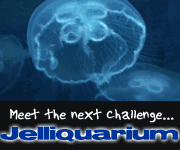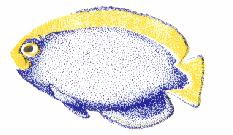|
Phylum cnidaria
By Jim Wolf, Marine Biologist
The Cnidarians compromise a very diverse group of organisms. All Cnidarians
(anemone like organisms) share a similar body plan. They can be simply
described as a sac with in a sac. These critters posses no distinct head,
digestive or structural organs, and all possess Cnidae (specially modified
stinging cells). Cnidarians can exist as either a polyp (an anemone like
organism), or a medusa (a jellyfish like organism ). It is the degree to
which these three groups of Cnidarians exists as either a polyp or medusa
that help taxonomists identify them.
The
Hydrozoans are the first group we will discuss. There about
2700 species of hyrozoans, and most of the are marine. A Hydra, fire coral
or the imfamous Man-O-War are perhaps some of the more familiar examples
of the hydrozoa. All hydrozoans alternate between a polyp, and a medusa
phase of living. They may occur as microscopic attached forms, or be fifty
feet long and live in the open ocean. Despite their prevalence, they are
very rarely seen in tropical fish stores.
Scyphozoans
are the next group of Cnidarians, and they are the familiar jellyfish.
The 200 plus species of scyphozoans are all marine free swimming medusa.
Jellyfish require good water quality, and specific tank, called a Kreisel,
to swim in. Exhibits of jellyfish are a big draw at public aquariums. They
can range from 1 cm. clear blobs to barrel sized multicolored organisms
that look positively bizarre. Only the curious bottom dwelling Cassiopeia
is found in fish stores. This tropical jelly fish lives up-sidedown on
the bottom of shallow tropical lagoons, only moving when disturbed. They
survive by harvesting the algae that they culture within their tissues.
A well lit aquarium with a tranquil patch of sand is their prefered environment.
Cubozoans
contain 15 different species, such as the Box Jellyfish. Some are as large
as 12 inches, but most are 1 to 2 inches. These jellyfish are extremely
dangerously. Their sting can be lethal.
Anthozoans
are the familiar anemones and corals. There about 6000 species of anthozoans,
and they all exist exclusively as a polyp. There are two general groups
of anthozoa that will interest the hobbyist. The first is the anemones
and true corals. These animals usually can be readily identified as a Cniderian
due to their large conspicuous polyp like structure. The other group are
the gorgonian like animals. These animals are a bit more difficult to characterize.
Soft corals, sea pens and gorgonians all are included in this group. Usually
the polyp is quite small, and will bear eight tentacles. An fairly crude
yet accurate way to tell the difference is that many octocorals do not
resemble anemones at first glance. The specimen may appear tree like, feather
like, and or encrusting and the tentacles will bear smaller tentcles (pinnate).
Midwater Systems has
developed a custom acrylic
jellyfish tank, called the Jelliquarium, and is working on holding systems used to keep
these midwater collections and gelatinous organisms in
suspension. Click here for information on the

or
browse the links below for more information on..... |













